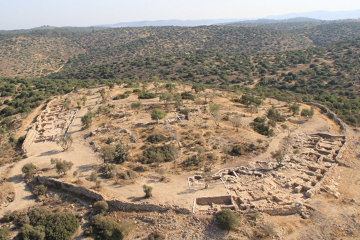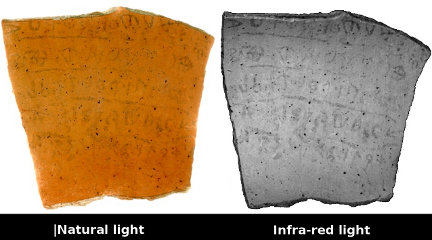Where David slew Goliath
Khirbet Qeiyafa is rapidly turning into one of the most important excavations ever conducted in Palestine. The significance of the site is not so much in its size - it is pretty small - nor in the plethora of objects found there, but in the significance of what has been discovered.

| |
| Khirbet Qeiyafa from the air |
The background to the case is the claim made by Israel Finkelstein that David and Solomon were mythical, that the archaeological record indicates that Jerusalem was little more than a village and whatever rulers there may have been around 1000 BC were nothing more than clan chieftans or tribal sheikhs - and pretty small and insignificant tribes at that.
Finkelstein was correct - he is a well respected archaeologist - in stating that the archaeological record did not bear out the Biblical tales of a rich and powerful Israel under King David. Very little from the Iron Age had been found in Jerusalem (but of course, very little excavating had been done in the area, which was thickly inhabited by modern Arabs who were not sympathetic to Jewish desires to find their forebears under the foundations of the Arabs' homes!) Where he went wrong, of course, was in ignoring the testimony of the Bible, whose historical records have a delightful habit of being proved accurate just when the critics were at their loud-mouthed fiercest.
And sure enough, this is what has happened with Finkelstein. First of all a substantial stone building was discovered in just the area where Solomon's palace might have been, complete with a seal impression that may have belonged to a court official mentioned in the Bible. This occasioned considerable delight among those who love and respect the Bible, but Finkelstein was able to claim, with a certain amount of plausibility, that the excavation had not been done correctly or had been misinterpreted or was an exception that proved the rule.
But then came Khirbet Qeiyafa, a site on the edge of the Valley of Elah, which was not overlain by Arab houses and which could be cleanly and unambiguously excavated. Work began in 2007 by Yosef Garfinkel of the Hebrew University and Saar Ganor from the Israeli Antiquities Authority. To their delight the city proved to be from the Iron II period and carbon-14 dates from two burned olive stones put the site at 1050-970 BC.
By conventional chronology, David began to reign in 1011 BC and we presume the incident of David and Goliath happened ten to twenty years before that. This would mean that Khirbet Qeiyafa could have been founded at the time when David was squaring up to Goliath and picking stones to go in his sling. In fact, the proximity of the site to the Valley of Elah where the battle took place makes it extremely tempting to link the two.
A possible scenario is that Saul began to build the fortress city of Khirbet Qeiyafa right on the edge of Philistine territory. The Philistines came out in opposition, only to find that the Israelite army was ensconced in a strong position on the heights overlooking the valley, too firmly entrenched to be attacked. The Philistines therefore took to parading their champion each morning to shout insults at the Jews in the hope of luring them down. Meanwhile work on the new fortress continues apace and the Philistines are getting more and more disheartened at their failure to stop the building work or to provoke the Israelites into attacking them.
At this point young David arrives and deploys his secret weapon. His deadly accurate aim puts a stone in the giant's forehead and as he grabs the Philistine's sword and slashes at his neck, the already low morale of the Philistines reaches rock bottom and they turn and head for home. The Israelites stream down from their hillside and chase them as far as Ekron and Gath.
The interesting thing is the mention of Shaaraim in 1 Samuel 17:52, which shows that the city was in existence at this time, but the archaeology proves that it must have been a very new city - brand new if my reconstruction is correct.
Of course, we do not know for certain that Khirbet Qeiyafa is Shaaraim, but the word means "two gates" and the archaeologists have demonstrated that Khirbet Qeiyafa does indeed have two gates! Other possible identifications are Azekah, Netaim or even the Philistine city of Gob. Against this Garfinkel points out that while the bones of goats, sheep, cattle and fish have been found in Khirbet Qeiyafa, no pig or dog bones have been found and we know from sites that are definitely Philistines that they ate both pigs and dogs.
There are other evidences as well. The lay-out of the town inside the walls of Khirbet Qeiyafa is typical of nearby Judean sites such as Beit Shemesh, Tel Beit Mirsim and Beersheba. The city was surrounded by a casemate wall, which is not known from any Philistine or Canaanite site.
Then there is the pottery, which not only confirms the Iron II date, but bears a curious and distinctive feature. As many as 500 jar handles have been found which are marked with one or more fingerprints pressed into the clay before the jar was baked. Marking jar handles in this way was a Judean practice.
The interesting thing is that the quantity and size of these jars indicates that Khirbet Qeiyafa or Shaaraim held substantial stores. It is possible, of course, that the city maintained such stores in case of attack and siege by the Philistines, but another possibility is that the city was an administrative centre from which food was sent elsewhere, probably to a royal palace.

| |
| The ostracon by natural light (left) and infra-red (right). |
Unfortunately there is no scholarly consensus about the one object that might possibly settle the question of who built Khirbet Qeiyafa. In 2008 an ostracon in poor condition was discovered on which were five lines of writing. Two years later the University of Haifa issued a press release claiming that the language of the ostracon was definitely Hebrew and that the text was a prophetic message urging that the judges should act on behalf of the poor, slaves and widows. Social justice was, of course, a concern of Biblical prophets and entirely different from the prophetic texts of heathen religions which dealt with the gods and how they should be worshipped.
Other scholars have dismissed this interpretation and declared that the writing is Canaanite and one man, Millard, actually claims that it is nothing more than a list of names written by someone who couldn't spell very well!
However there is one thing on which almost all the scholars agree: Khirbet Qeiyafa represents a well-organised government, able to command a large enough work force that many of the stones in the walls weigh three to five tons! This was no village council taking measures to defend their pitiful huts; this was a national government that could summon, plan for, employ, feed and direct a large workforce. Furthermore, so much effort must have been directed towards a worthwhile end - not just the defence of an insignificant border outpost, Khirbet Qeiyafa was an important administrative centre, overseeing the collection of taxes or tribute from a turbulent border area and ensuring their safe delivery to the capital, wherever that was.
The latest discovery merely underlines this conclusion. A large, rectangular stone structure, spotted during the early work on the site, has now been cleared and identified as a palace. The building, which is 100' on each side, had a number of workshops in its rooms, with evidence for metal working, a pottery, plus fragment of Egyptian alabaster. Professor Garinkel triumphantly declared, "This is indisputable proof of the existence of a central authority in Judah during the time of King David."
Whether King David - or Saul before him - ever actually lived in Shaaraim is not known and really is not important. No one other than the ruler of a centralised, organised kingdom could - or would - have built such a fortified administrative centre.
Finkelstein and his sympathisers are, of course, doing their best to discredit the conclusions reached by the excavators and I am sure that their efforts will help to make facts and interpretations more certain. Truth never needs to fear scrutiny and in this case it is Biblical truth, as much as Garfinkel and Ganor's academic reputations, that will, I am confident, be confirmed.
1011 BC If Ahab's final year was 853 BC (see the article on chronology and on Edwin Thiele) and the kings before him reigned for 78 years, which takes us to 931 BC for the death of Solomon. Solomon reigned for 40 years (1 Kings 11:42) and David reigned for 40 years (1 Kings 2:11), which takes us to 1011 BC. It does seem slightly suspicious that Eli ruled for 40 years and Saul is commonly thought to have reigned for 40 years, but as these are the only figures we have, we must work with them. Return
casemate wall Two parallel walls were built six to ten feet apart. The space between them was divided by cross walls into rooms and in some cases doorways were provided in the inner wall so that the rooms could be used for storage. In the case of Khirbet Qeiyafa, houses were built against the inner wall and incorporated the casemate rooms as part of the house. Return
© Kendall K. Down 2013





